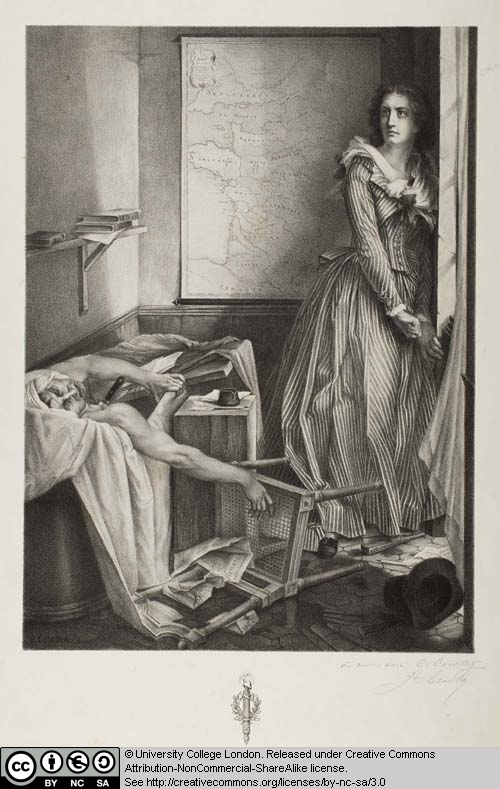25 Letoula's Corday

Jules Letoula (1832 –
?), after Paul Baudry (1828 – 1886)
Charlotte Corday ,
1863
Lithograph
Publisher unrecorded
Letoula’s lithograph is a faithful rendering of Paul
Baudry’s large-scale (203 x 154cms) painting of Charlotte Corday executed in
1860 and exhibited at the annual Paris Salon exhibition the following year. It
is a heroic representation of Corday, a subject popular throughout the
nineteenth century with historians, poets, painters and their audiences, for
whom she was something of a national icon. She was often compared with Joan of
Arc who also ‘saved’ the nation from a murderous tyrant. This idea is
reinforced by Baudry who frames Corday’s figure against a map of
Corday is depicted in the moments immediately following her
murder of Marat, whose left hand grips the edge of the bathtub, suggesting he
is still alive. Similarly, Corday’s hand maintains the position it would have held
as she clutched the knife, now embedded in Marat’s chest. The disjointed
appearance of her right arm and hand is expressive of her shock at having
committed the deed and of her fearful anticipation of its repercussions, the
latter emotion also expressed by her left hand, which grips the wall. Her goal
accomplished, she awaits arrest: the shadows cast by the window frame evoke the
bars behind which she will be imprisoned before her execution. Corday’s upright
figure, physical beauty, and stoicism stand in marked contrast to the artist’s
foreshortened and awkward depiction of Marat, his face contorted with pain and
frozen in an ugly grimace as he breathes his last, leaving us in no doubt where
our sympathies should lie.
When exhibited in
Licensed under the Creative Commons Attribution Non-commercial Share Alike 3.0 License
This resource has been released as an open educational resource (OER) on a Creative Commons 'Attribution Non-commercial Share Alike' license. This means that once downloaded, content can be modified and improved to complement a particular course. This requires, however, that improvements are recycled back into the OER community. All content present at the time of download must be accordingly credited and, in turn, novel content must be appropriately licensed.